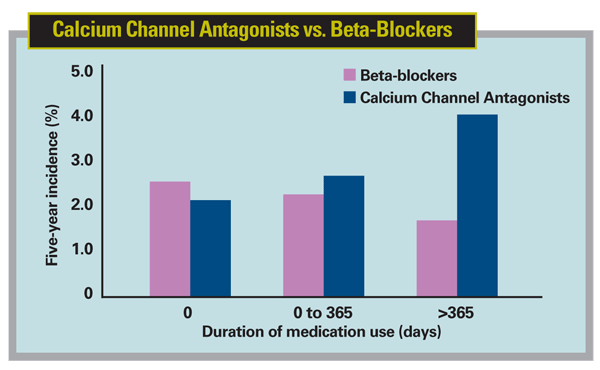A group at
The retrospective, interventional, comparative cohort study reviewed 8,601 consecutive pars plana vitrectomy surgeries at Wills. Endophthalmitis developed in 1 of 5,498 eyes after 20-ga. vitrectomy (0.018 percent) and in seven of 3,103 eyes after 25-ga. vitrectomies (0.23 percent; p= 0.004). Median final visual acuity was counting fingers or hand movements (range, 20/50 to no light perception), with comparable results between 20-ga. and 25-ga. endophthalmitis cases.
(Ophthalmology 2007;114:2133-7)
Kunimoto DY, Kaiser RS.
Multifocal IOLs Produce Similar Patient Satisfaction Levels
A study in the United Kingdom comparing the visual outcomes in patients with bilateral implantation of AcrySof ReSTOR multifocal intraocular lenses (Alcon) or ReZoom multifocal IOLs (Advanced Medical Optics) found that ReSTOR provided better near vision and the ReZoom IOL better intermediate vision six months after cataract surgery.
The study followed patients who had uneventful bilateral cataract extraction with implantation of the two multifocal IOLs, with 50 patients in each arm. Parameters evaluated six months after second-eye surgery included: binocular uncorrected distance, intermediate and near acuities; spectacle independence; subjective visual symptoms; and patient satisfaction.
All patients had binocular uncorrected distance visual acuity of 20/32 or better, with no statistically significant difference between the groups. The mean binocular uncorrected near acuity was 20/26 (J1.22) in the ReSTOR group and 20/34 (J2.34) in the ReZoom group (p<.0001). The mean binocular uncorrected intermediate VA was 20/42 and 20/34, respectively (p=.003). Patients in the ReZoom group reported greater satisfaction with intermediate vision (p=.04). No statistically significant difference was found in satisfaction with near vision. Eighty-six percent of ReSTOR patients and 70 percent of ReZoom patients did not wear glasses for daily activities; the overall satisfaction was not statistically significantly different between groups. Nor was there any significant difference in photic phenomena.
(J Cataract Refract Surg 2007;33:2057-61)
Chiam PJ, Chan JH, Haider SI, Karia N, Kasaby H, Aggarwal RK.
Systemic Antihypertensive Drugs and Open-Angle Glaucoma
Researchers at the
The prospective population-based cohort study consisted of a subset of 3,842 participants of the Rotterdam Study for whom data from identical ophthalmologic examinations at baseline and follow-up were available. They recorded the use of antihypertensive medication over an average follow-up of 6.5 years. Associations between incident open-angle glaucoma and antihypertensive medication were assessed using multivariate logistic regression models adjusted for age, gender, duration of follow-up, intraocular pressure, intraocular pressure-lowering medication, and cardiovascular disease.
During follow-up, there were 87 incident cases of open-angle glaucoma. Participants using calcium channel antagonists had a 1.8-fold (95 percent confidence interval, 1.04-3.2; p= 0.037) higher risk of developing incident OAG. Beta-blockers were associated with a nonsignificant risk reduction (odds ratio, 0.6; 95 percent CI, 0.3 to 1.02; p=0.06). None of the other classes of antihypertensives was significantly associated with incident OAG.
(Ophthalmology 2007;114:2221-6)
Müskens RP, de Voogd S, Wolfs RC, Witteman JC, Hofman A, de Jong PT, Stricker BH, Jansonius NM.
A New Tack in Assessing Persistence with Therapy
A group associated with
Patients with a pharmacy claim for a 2.5-ml bottle of latanoprost, travoprost or bimatoprost between September and December 2002 were identified from a retail pharmacy database and were followed up for 12 months. Three separate analyses defined gaps in therapy as spans in excess of 45, 60 or 120 days without a refill for the same medication. Patients were categorized by the number of gaps in therapy and the cumulative length of gaps. A Kaplan-Meier analysis was conducted using a 120-day allowable refill period.
For refill periods of 45, 60 and 120 days, 10.6 percent, 28.6 percent, and 77.5 percent of patients, respectively, had no gaps in therapy, and 32.6 percent, 53.4 percent, and 86.5 percent, respectively, had 30 days or fewer off therapy annually. According to the 45-day threshold analysis, 50.7 percent of patients had three or more gaps vs. 18.5 percent in the 60-day analysis and none in the 120-day analysis. The Kaplan-Meier curve shows 88.6 percent and 76.1 percent of patients were persistent for 120 days and one year, respectively.
The group suggests that their approach may better parallel clinical experience with patient persistence, in which patients stop and restart medications for a variety of reasons over time. This method also may help to identify avenues for investigation of lack of persistency among many patients.
(Am J Ophthalmol 2007;144:520-524)
Lee PP, Walt JG, Chiang TH, Guckian A, Keener J.
Surgical Confusions Rare But Mostly Preventable
Researchers associated with
The most common confusion was wrong lens implants, accounting for 67 cases (63 percent). Wrong-eye operations occurred in 15 cases, wrong-eye block in 14, wrong patient or procedure in eight, and wrong corneal transplant in two. The use of the Universal Protocol, they say, would have prevented the confusion in 90 cases (85 percent). Though surgical confusions in ophthalmology usually cause little or no permanent injury, consequences for the patient, the physician and the profession may be serious. Measures to prevent such confusions deserve the acceptance, support and active participation of ophthalmologists, the group concludes.
(Arch Ophthalmol 2007;125:1515-22)
Simon JW, Ngo Y, Khan S, Strogatz D.



